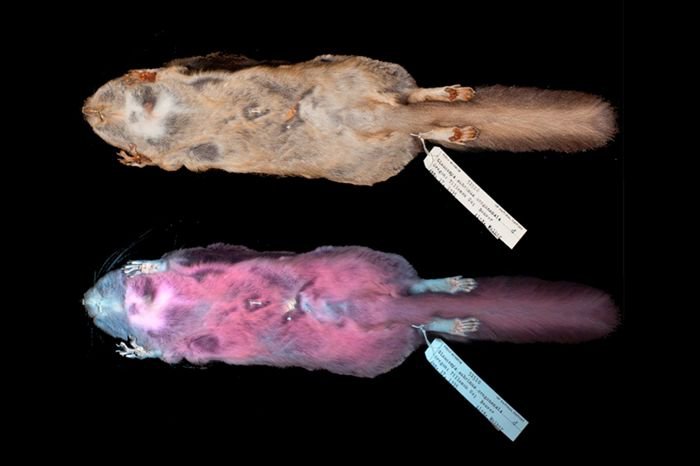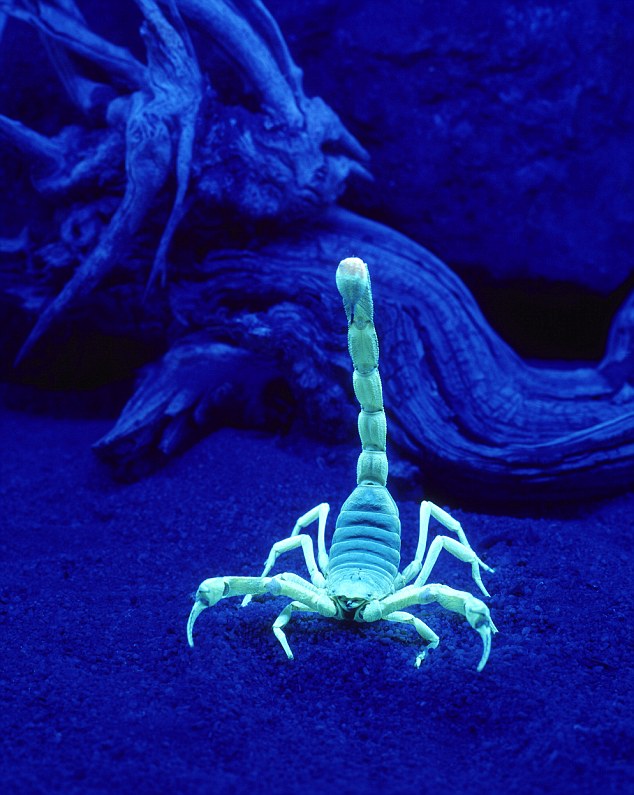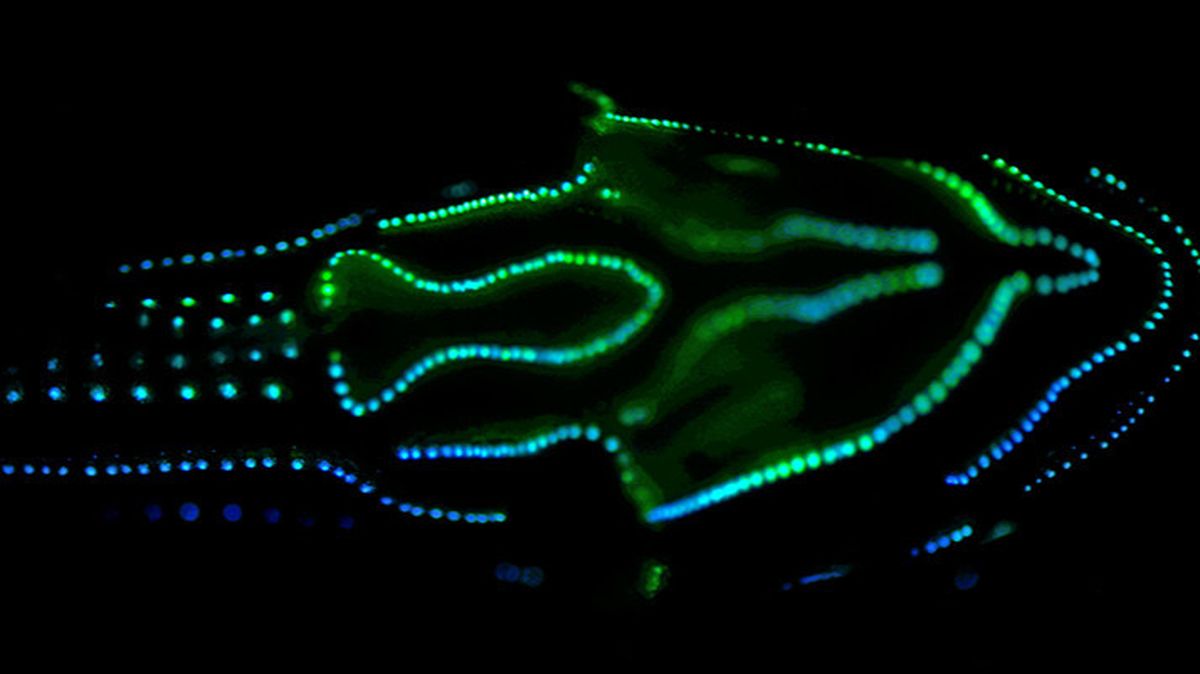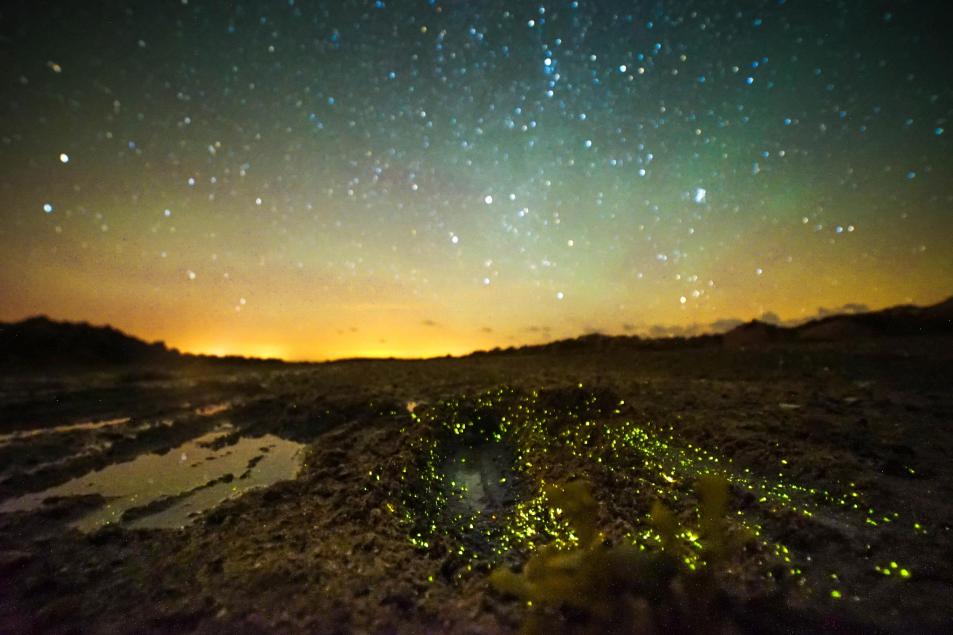It looks like you're using an Ad Blocker.
Please white-list or disable AboveTopSecret.com in your ad-blocking tool.
Thank you.
Some features of ATS will be disabled while you continue to use an ad-blocker.
15
share:
No, I'm not suffering DT's and I didn't take '___' either. This is an actual journal article from Journal of Mammalogy.
Ultraviolet fluorescence discovered in New World flying squirrels (Glaucomys)
You can read the abstract there but I am too cheap to pay $45 to access the article. I do have the next best thing - 2 news articles.
Fox: Hot pink flying squirrels? Wisconsin biologist shocked to find creatures glow in the dark has video
Newsweek: These Flying Squirrels Glow Bubblegum Pink Under UV Light

picture from twitter
Ultraviolet fluorescence discovered in New World flying squirrels (Glaucomys)
You can read the abstract there but I am too cheap to pay $45 to access the article. I do have the next best thing - 2 news articles.
Fox: Hot pink flying squirrels? Wisconsin biologist shocked to find creatures glow in the dark has video
A Wisconsin biologist made an unexpected discovery with an ultraviolet flashlight in hand one crisp spring night: a hot pink flying squirrel.
Jon Martin, who's also a professor at Northland College in Ashland, spotted the pink bubblegum-hued mammal in his UV beam as the creature feasted at a birdfeeder.
"I point the light at it and bam! Pink fluorescence," Martin told Newsweek.
...
"Fluorescence in varying intensities of pink was observed in females and males of all extant species across all sampled geographic areas in North and Central America and a temporal range of 130 years," the group wrote in a synopsis of their research.
It's still unclear why the creatures' naturally brown fur turns that shade of pink under UV light, though some guess it may be a way to communicate or identify their own species around dusk and dawn when they typically are the most active.
Newsweek: These Flying Squirrels Glow Bubblegum Pink Under UV Light
Out of 135 museum squirrel specimens studied, the team found only members of the Glaucomys genus—New World flying squirrels—glimmered pink, Nature reported. Shine ultraviolet light on the critters that glide from tree to tree in forests from Honduras to Alaska, and they will shimmer. But the researchers don't know what effect this has on the squirrels, so they advise not to try it out on living animals in the wild.
The fur of other squirrels—the eastern gray squirrel (Sciurus carolinensis), the fox squirrel (Sciurus niger) and the American red squirrel (Tamiasciurus hudsonicus)—had no such glow.
Researchers don’t know why the creatures' fur turns cotton-candy pink, but they think it might help them recognise each other when there isn’t much light, the team told Newsweek. It might also help them avoid predators, or have no special function at all. "This trait could just be a cool color they happen to produce," Kohler said.

picture from twitter
a reply to: toms54
Do your think the flying squirrels can see into the UV spectrum (so they can see each other better)? Or maybe there is a predator out there that feeds on them, that can see in UV? Or is it just a coincidence and means nothing?
This is interesting, thanks for posting it
Do your think the flying squirrels can see into the UV spectrum (so they can see each other better)? Or maybe there is a predator out there that feeds on them, that can see in UV? Or is it just a coincidence and means nothing?
This is interesting, thanks for posting it
a reply to: LookingAtMars
I looked around a little. One place said they see only blue and yellow, less colors than a human and another said, "Also, certain times of day have different proportions of UV in the environment. It just so happens that proportions are highest during crepuscular/nocturnal times of day, when the flying squirrels are most active. They also have uniquely transparent eye lenses that let these UV wavelengths through their eyes; but the real question is, does their brain process this information (can they see it)?"
So I don't have a clear answer but now you have me curious.
I looked around a little. One place said they see only blue and yellow, less colors than a human and another said, "Also, certain times of day have different proportions of UV in the environment. It just so happens that proportions are highest during crepuscular/nocturnal times of day, when the flying squirrels are most active. They also have uniquely transparent eye lenses that let these UV wavelengths through their eyes; but the real question is, does their brain process this information (can they see it)?"
So I don't have a clear answer but now you have me curious.
Darwinism is not a thing but natural selection is.
Have you seen the glow in the dark fish?
www.glofish.com...
Have you seen the glow in the dark fish?
www.glofish.com...
originally posted by: Phage
Darwinism is not a thing but natural selection is.
Have you seen the glow in the dark fish?
www.glofish.com...
What color are they without the blue lighting? Just a non-fluorescent counterpart? So without the blue light, Instead of "galactic blue" it's just blue?
a reply to: KansasGirl
Yeah, they work with blacklights too though.
And without a blacklight, the squirrels are just squirrel colored.
Yeah, they work with blacklights too though.
And without a blacklight, the squirrels are just squirrel colored.
edit on 2/4/2019 by Phage because: (no reason given)
That's pretty cool! I remember finding out about scorpians fluorescing under UV and thinking it would be cool to build a complete UV tank and get a
few, wifey said no to that too, lol;


Most are probably aware, but for those who aren't, some fish species, and others (fireflies etc.) don't require a UV light source to flouresce - they use bioluminescence,
This is clearly, in my view at least, inspiration for the alien creatures in the movie Abyss, a fantastic movie for those who haven't seen it!;

I like what they did with Avatar too
Here's a bonus picture of some local bioluminescence;

Cool thread, I love stuff like this so S&F!


originally posted by: KansasGirl
originally posted by: Phage
Darwinism is not a thing but natural selection is.
Have you seen the glow in the dark fish?
www.glofish.com...
What color are they without the blue lighting? Just a non-fluorescent counterpart? So without the blue light, Instead of "galactic blue" it's just blue?
Most are probably aware, but for those who aren't, some fish species, and others (fireflies etc.) don't require a UV light source to flouresce - they use bioluminescence,
This is clearly, in my view at least, inspiration for the alien creatures in the movie Abyss, a fantastic movie for those who haven't seen it!;

I like what they did with Avatar too
Here's a bonus picture of some local bioluminescence;

Cool thread, I love stuff like this so S&F!
Get yourself a UV LED hand light ("torch," "flashlight," etc.). They're cheap; a small USB-rechargeable model saves on the cost of batteries and
lasts for many years.
You will be astonished at some of the colors you'll see when using it in the dark, because it makes some things fluoresce and it makes some colors change. For instance, tonic water glows an eerie green because the trace amounts of quinine fluoresce under UV light. Depending on the pigments used, some yellows remain yellow, and some yellows appear black. If you want to collect scorpions, a UV light will make them glow from 30 feet away and they're super easy to spot. Easier to find at night than during the day.
Get a UV light and have some fun.
If you have a dog or a cat, don't use the light to inspect any carpeting you have. You will hate your critter
You will be astonished at some of the colors you'll see when using it in the dark, because it makes some things fluoresce and it makes some colors change. For instance, tonic water glows an eerie green because the trace amounts of quinine fluoresce under UV light. Depending on the pigments used, some yellows remain yellow, and some yellows appear black. If you want to collect scorpions, a UV light will make them glow from 30 feet away and they're super easy to spot. Easier to find at night than during the day.
Get a UV light and have some fun.
If you have a dog or a cat, don't use the light to inspect any carpeting you have. You will hate your critter
new topics
-
Florida man's trip overseas ends in shock over $143,000 T-Mobile phone bill
Social Issues and Civil Unrest: 2 minutes ago -
Former Labour minister Frank Field dies aged 81
People: 2 hours ago -
SETI chief says US has no evidence for alien technology. 'And we never have'
Aliens and UFOs: 3 hours ago -
This is our Story
General Entertainment: 6 hours ago -
President BIDEN Vows to Make Americans Pay More Federal Taxes in 2025 - Political Suicide.
2024 Elections: 8 hours ago -
Ode to Artemis
General Chit Chat: 9 hours ago
top topics
-
University student disciplined after saying veganism is wrong and gender fluidity is stupid
Education and Media: 17 hours ago, 14 flags -
President BIDEN Vows to Make Americans Pay More Federal Taxes in 2025 - Political Suicide.
2024 Elections: 8 hours ago, 12 flags -
Should Biden Replace Harris With AOC On the 2024 Democrat Ticket?
2024 Elections: 15 hours ago, 6 flags -
One Flame Throwing Robot Dog for Christmas Please!
Weaponry: 13 hours ago, 6 flags -
Don't take advantage of people just because it seems easy it will backfire
Rant: 13 hours ago, 4 flags -
Ditching physical money
History: 13 hours ago, 4 flags -
SETI chief says US has no evidence for alien technology. 'And we never have'
Aliens and UFOs: 3 hours ago, 4 flags -
Former Labour minister Frank Field dies aged 81
People: 2 hours ago, 3 flags -
Ode to Artemis
General Chit Chat: 9 hours ago, 3 flags -
This is our Story
General Entertainment: 6 hours ago, 2 flags
active topics
-
Florida man's trip overseas ends in shock over $143,000 T-Mobile phone bill
Social Issues and Civil Unrest • 0 • : Consvoli -
So this is what Hamas considers 'freedom fighting' ...
War On Terrorism • 244 • : HopeForTheFuture -
"We're All Hamas" Heard at Columbia University Protests
Social Issues and Civil Unrest • 269 • : Vermilion -
Police clash with St George’s Day protesters at central London rally
Social Issues and Civil Unrest • 42 • : ohahhupthera -
University student disciplined after saying veganism is wrong and gender fluidity is stupid
Education and Media • 42 • : TzarChasm -
Russia Ukraine Update Thread - part 3
World War Three • 5721 • : stu119 -
President BIDEN Vows to Make Americans Pay More Federal Taxes in 2025 - Political Suicide.
2024 Elections • 22 • : CarlLaFong -
Tucker Carlson UFOs are piloted by spiritual entities with bases under the ocean and the ground
Aliens and UFOs • 43 • : Xtrozero -
Thousands Of Young Ukrainian Men Trying To Flee The Country To Avoid Conscription And The War
Other Current Events • 127 • : Consvoli -
1980s Arcade
General Chit Chat • 25 • : confuzedcitizen
15
